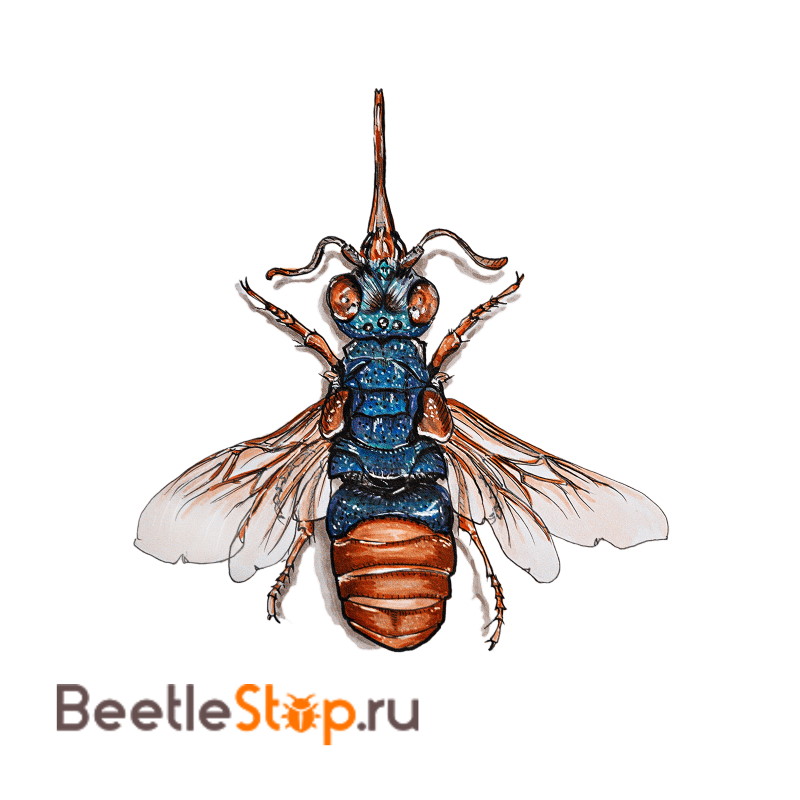Large parnople - a brilliant danger for bambex wasps
The family of chrysidides (Chrysididae) or the wasp-sheath belongs to the order Hymenoptera insects. Its representatives are known for their bright brilliant coloring and parasitoid lifestyle. Their larvae grow and develop in the nests of sand wasps, eating offspring and supplies of the owners. Chrysidides prefer arid zones - places with a dry and hot climate. Parnopes, a small genus of wasps, consists of 11 species, and Europe is inhabited by only one - large parnepes.

Morphological description of the species
Parnopes grandior (Parnopes grandior) belongs to the superfamily Chrysidoidea, the family wasp-glitter or golden wasp. This is the only representative of a kind in Europe and Russia. One of the largest types of glitter is called meat-red and proboscis. The size of the imago is 8-14 mm, the body is elongated. The head is heart-shaped with a groove in the parietal part. Large complex eyes are located on the sides of the head, allowing you to see in different directions at the same time. Between them are three simple eyes.
Information. A characteristic feature of the papillas is a large elongated proboscis, by which the insect is able to get nectar from the bottom of deep peduncles.
The head, chest and first tergite of the abdomen are painted green-blue with a metallic sheen. The remaining two tergites and females and three in the male are orange-red. The hips of the extremities are dark green with silvery hairs, and the legs and feet are red and yellow. The chest is expanded, it protrudes noticeably on the sides, between the coxae of the front and middle legs. The tip of the hind chest is serrated, hanging over the abdomen.
Sparkles have a special shape of the abdomen, its upper part is convex and the lower concave. This is necessary for folding in a protective position when attacking angry wasps, in the nests of which a paired dog invades. The integument of the body of chrysidides is not only shiny, but also very dense, they protect against stings and stings by a sting. Head and chest at large puncture points. The ovipositor of insects is long, telescopic, in the usual state it hides in the abdomen. The spangles have two pairs of webbed darkened wings. Anterior with a discoidal cell. Wing caps well visible, painted brownish yellow.
Distribution area
A large parnepods lives in Central and Western Europe, in northern Africa, in South-West Asia, and Kazakhstan. This type of glitter is found in the middle lane and in the south of Russia. Insects are noted in Moldova and Ukraine.
Lifestyle and breeding features
Proboscis blandes choose sites with a climate close to desert. They settle in areas with sandy soils, along the banks of rivers and lakes. Insects choose well-warmed areas, can live on the side of the road, on the southern slope of the railway embankment. Parnopez belongs to single wasps. Males and females are found for mating only during the breeding season. Years of adults are observed in July-August. They do not build nests, and the care of the offspring is transferred to the sand wasps of the bambex family or fly-eaters. As the host are used: Bembix repanda, Bembix oculata, B. integra, B. tarsata. The female enters the bambex nests and lays an egg.
Adults feed on pollen and nectar of flowers, and carnivorous larvae are offspring of bambex.They are called parasitoids, insects that eat the host in the process of development, and in adulthood, living independently. Interestingly, the larva of the host larva leaves at the end of development. First, he feeds on stocks brought into the nest. Females of sand wasps bring to the offspring of caught, but not paralyzed flies, it is they who make up the diet of the little spangles.
At the final stage of development, the larva pupates, in this state it hibernates in the host’s nest. In the summer of the next year, young large dogmen appear. One generation develops per year.
Limiting factors and protective measures
About 100 years ago, the species Parnopes grandior was common in Russia. In the last decade, entomologists have no information about local insect populations. A large parnepos is listed in the Red Book of the Russian Federation as a species that is declining in number. In some areas, wasps also came under protection. They are included in the list of endangered insects in the Belgorod, Tula, Volgograd regions and Crimea.
The decrease in the number of glitter is associated with the loss of habitat of bambex. The sandy areas where wasps settled are overgrown with grass and are used for development. The area of expansion of the parnepesa in search of new habitats is small. To restore the number of spangles, it is necessary to mow the grass near the nests of the bambex nasal, to prohibit the use of insecticides at a distance of 200 m.

